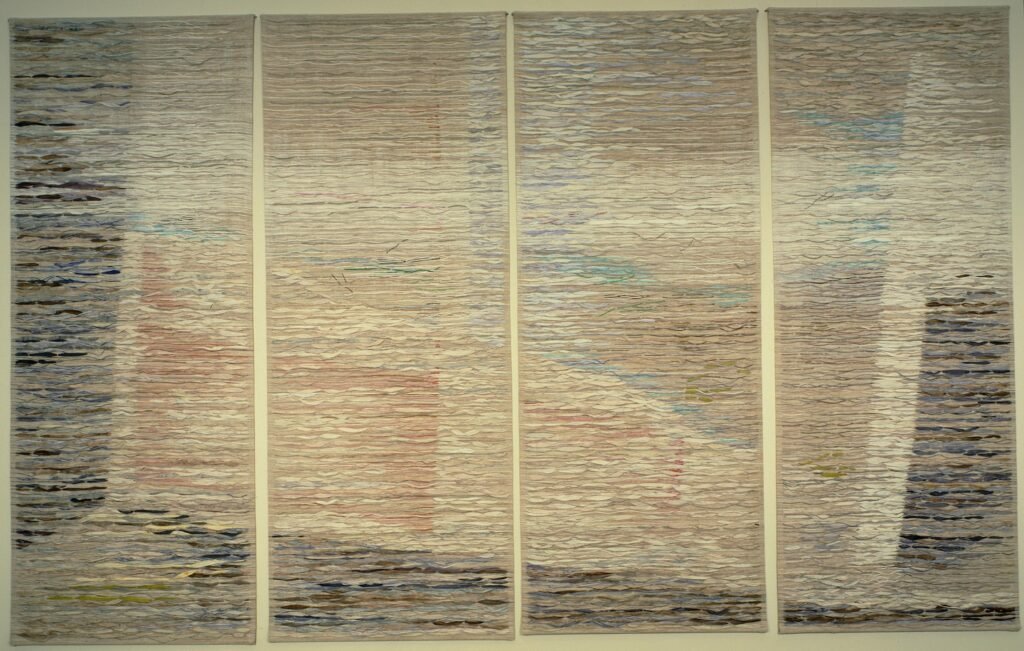The objects roughly divide between pictures and sculptures, and the latter are usually more striking. Often suspended in air, many of the sculptural works have a near-liquid quality that evokes clouds, waterfalls and marine life.
Entering the show, visitors will encounter Claire Zeisler’s “Coil Series III — A Celebration,” a cascade of white strands that turn blood red at the bottom, where they pile in a tangle. The piece is austerely minimalist, yet has a fleshy quality. Around the corner is Lenore Tawney’s “Box of Falling Stars,” a diaphanous rectangle drawn in space with dangling linen threads. The gossamer strands evoke a mist, defining the space while leaving it mostly open.
Further on, two neighboring pieces that appear organic seem to bob as if at sea. Made of the kind of white filament used for fishing line, Kay Sekimachi’s “Nagare VII” is abstract but suggestive of a squid in motion. (“Nagare” is Japanese for “flow.”) Neda Al-Hilali’s mixed-fiber “Medusa” is similar in size and shape, yet has a very different vibe. Where “Nagare VII” looks clean and elegant, “Medusa” appears dark and damaged. While the two pieces elicit different responses, each benefits from the other’s presence.
Another pairing juxtaposes two untitled works by the same artist, Judith Scott. Both are found objects swaddled in fabric, but one projects upward like a small tree while the other hangs like a cocoon. The bulky creations are enticingly mysterious, like gift boxes that perpetually tantalize because they can never be unwrapped.
Many of the non-sculptural pieces use quilting techniques in nontraditional ways. Emma Amos’s “Winning” mixes painting and embroidery to show a silhouetted woman vaulting toward victory on a patchwork backdrop. Carolyn Mazloomi’s “The Family Embraces” renders African-style masks and figures in seemingly chiseled black-and-white forms that resemble those of a wood- or linocut print.
Faith Ringgold is probably the best-known artist in the show. Her “The Bitter Nest, Part II: The Harlem Renaissance Party” centers on a cartoon-style painting of such notables as Langston Hughes, Zora Neale Hurston and W.E.B. Du Bois around a table. The picture is flanked by patchwork patterns and two columns of handwritten text. Another mixed-media chapter in African American history, L’Merchie Frazier’s “From a Birmingham Jail: MLK” is a collage of photo-transferred historical images and text on an array of silk banners.
Some of the pictorial works are more abstract. Cynthia Schira’s “Reflections” hints at landscape, but more due to its four-panel format than because of the thousands of tightly spaced lines that ripple across it. Highly stylized but evocative of an ocean scene, Adela Akers’s “By the Sea” complicates a simple design by splaying it across fabric ridged like a partly retracted curtain.
Susan L. Iverson’s woven “Ancient Burial IV — Night” pits earth-toned patterns reminiscent of traditional textiles against outbursts of bold color more typical of abstract-expressionist canvases. The softened geometric patterns of Mariska Karasz’s “Breeze” recall early-20th-century European art, which may reflect the influence of the artist’s childhood in Budapest.
Perhaps the most venerable of the show’s living artists is Sheila Hicks, a Nebraska native who has long been based in Paris. Her “The Principal Wife Goes On” is another of the show’s hanging pieces. Its tumbling brown cords are partly wrapped with threads of various bright colors, notably yellow and red. The contrast represents the transformation of raw fiber into refined textiles, and thus the making of any raw material into art. That may not be a subversive idea, but it is an audacious one.
Subversive, Skilled, Sublime: Fiber Art by Women
Renwick Gallery, 17th Street and Pennsylvania Avenue NW. americanart.si.edu. 202-633-7970.




